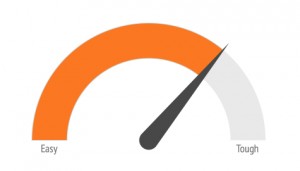 In a previous post, I complained that a game I was playing should have adapted the difficulty level of a mission after I’d failed it many times. I know, of course, that building in such smarts would require significant effort. I was wondering about how to make the process easier, and then I realized we already have the answer: the difficulty setting. That’s the slider or check boxes we often see at the start of a game that ask us if we want it set to “easy,” “medium,” or “hard.”
In a previous post, I complained that a game I was playing should have adapted the difficulty level of a mission after I’d failed it many times. I know, of course, that building in such smarts would require significant effort. I was wondering about how to make the process easier, and then I realized we already have the answer: the difficulty setting. That’s the slider or check boxes we often see at the start of a game that ask us if we want it set to “easy,” “medium,” or “hard.”
I have publicly opposed the idea of a difficulty setting several times. But now I realize that my objections weren’t to the concept itself, but to how and when it was presented. I believe now that a freely-adjustable difficulty setting is an elegant and simple mechanism for preventing the kind of frustration I was experiencing. I now think that a difficulty setting, handled properly, is a very good idea.
In retrospect, my objection to difficulty settings in games sprang from two causes.
First, many games offer a choice of setting before you know what the implications are. At the start of the game you are often led through a series of personalization choices, such as choosing the appearance and clothing of your protagonist, or the skills you start with. Then the game asks you to choose a difficulty level, often from three choices: Easy, Medium, Hard. At this point, you haven’t even played one second of the game, so you have no real basis for making this choice. So you guess. And I really dislike uninformed guessing.
Second, in many games once you’ve chosen your difficulty level, it’s fixed there. Games are getting better at letting you adjust this on the fly, but it’s by no means a universal feature. Many times I’ve started a game on one setting, and an hour or two into the game I feel that it’s too hard or too easy. The only way to change it is to start over again and repeat that hour of play, which is a drag. If I come to that realization 10 hours into the game, there’s no way I’m going to restart, so I’m stuck playing a game that isn’t really satisfying me.
These problems are both easily addressed, and by the same mechanism: allow players to freely adjust the difficulty at any time. And tell them that they can. Then the initial guess isn’t eternal, and I can back the setting off when I get frustrated and crank it up when I’m not feeling challenged enough.
I would prefer a continuous scale from super-duper-easy to impossibly-hard, but even a few pre-defined steps (Easy, Medium, Hard, Impossible) can do the trick. That way if I try a mission at my normal setting, and I get frustrated, I can dial it back to “a walk in the park” and be done with it.
As for trophies and achievements, many games already control these rewards based on the value of the difficulty. If you complete a given mission on hard, you might get the “hard” trophy for that mission alone. If you finish the whole game on hard but you did one mission on “easy,” then you get the “easy” trophy for the whole game. That is, you get a trophy corresponding to the lowest setting you used at any time. That seems entirely fair and reasonable to me.
The difficulty need to be be broadly defined, and include every aspect of what’s required from the player. It should control twitchy timing windows, the breadth and depth of memory tasks, the complexity of logic puzzles, and everything else that the player is required to master. Easy needs to really be that: easy. It’s the strain gauge, the pressure valve. When you just want to be done with something, go to easy, get through the task, and you’re done. Then crank the difficulty back up and continue.
In this way you don’t really need to know what the levels represent (do they change timing, angle, speed, armor, accuracy, etc.). All we need to know as a player is that if we’ve become frustrated, we can lower the difficulty and the frustration goes away, or if we’re not challenged, we can raise the difficulty until it’s as tough as we like.
It’s fun to change one’s mind sometimes, particularly when it’s a deeply-held belief. I was wrong to oppose difficulty settings. I’m now a big fan of variable difficulty settings that can be changed at any time.
